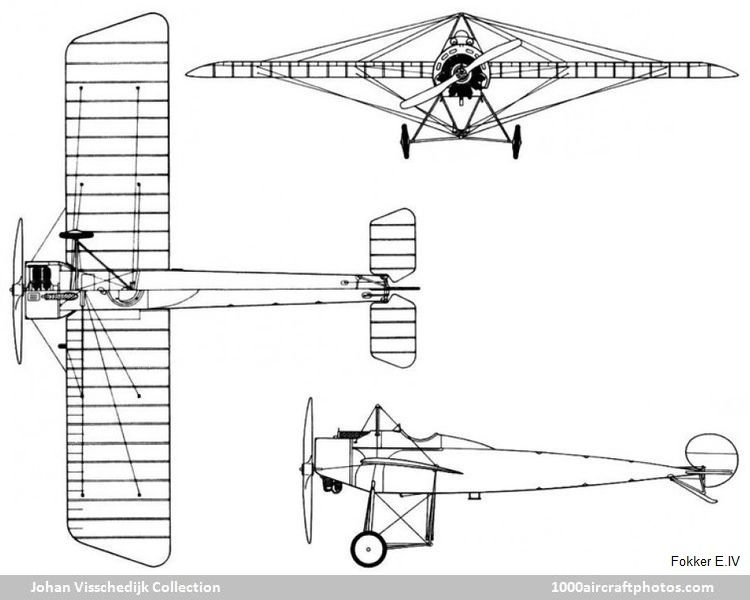The upper wing support pylon was again strengthened. An aluminum top decking covered the guns' breeches and ended with a streamlined, removable, rear section that extended down the fuselage behind the pilot. Additional air cooling for the double row of cylinders was provided by six large slots cut into the front upper face of the engine cowling.
The prototype M.15 (c/n 298), redesignated the Fokker E.IV and numbered E.122/15, was accepted on September 15, 1915 and shipped from the factory on November 27. Instead of being sent to the Western Front, it was diverted to Essen where intelligence reports had forecast a raid by Allied aircraft.
The raid failed to happen but, ever watchful of an opportunity, Fokker gave a display of its capabilities to the assembled German pilots and other officers present. Reports of the outcome of this conflict with one another. Fokker's said that he concluded his flying display with an impressive attack on a ground target using all three machine guns. Due to a malfunction of the synchronizing system, this was cut short when he put sixteen bullets through his propeller, causing him to land abruptly. He claims to have hidden the damage from those present until a replacement propeller was fitted, and that the aircraft was returned to Schwerin and eventually issued to Oswald Boelke at the front.
Hauptman Hermann Heise, commanding Flieger Ersatz Abteilung 7 and in the process of farming Kampfstaffel 1 at Cologne, was present at this firepower demonstration. In a report written after 1945, he stated that Fokker destroyed a number of propellers on the firing range in his attempts to get the synchronizing system to work with the three guns. So, far from the problem being hidden by Fokker, it was apparently general knowledge at the time. It is difficult to know which report to believe, but Heise had no reason to give anything but a factual account of the events.
Returned to Schwerin, E.122/15 was dispatched to the front on October 20, 1915. It is probable that by this time the third gun had been removed. At the front E.122/15 was flown by Oberleutnant Otto Parschau, then commanding Fokker Staffel Nord with the German 3rd Army. Parschau, a pre-war pilot, was a friend of Fokker's and had earlier flown and reported upon the first Fokker E.I. In his report on E.122/15, he says that its behavior was different to that of the 100 hp engined E.IIs and E.IIIs. In climbing turns under full power it needed a great deal of physical effort to operate the wing warping control and tight turns had to be made blipping the engine (see 'blipping' explanation below 3-view). The E.IV's speed made it difficult to judge the rate of approach to an enemy and he recommended that power be reduced when attacking from below or behind. Parschau complained of oil fumes during longer flights, but acceded that the fitting of a fire wall on later aircraft would cure the problem. He also reported a loss of power above 13,123 ft (4,000 m).
Leutnant Oswald Boelke was another early pilot of the E.IV and enjoyed a number of successes flying the type, but suffered a number of engine problems in the process. In his report on it he said that while it met the requirements for speed in level flight, its loss of speed in a climb above 9,842 ft (3,000 m) was such that Allied types could climb away from it. Its maneuverability was inferior to that of the E.IIs and E.IIIs, partly due to the gyroscopic effect of the heavy engine and partly because of the effort required to operate the wing warping system. Blipping the engine to allow quick turns resulted in a loss of altitude that was highly undesirable in combat. He found no use for the tilted alignment of the guns on the early aircraft (set at 15° to allow attack from behind and below) as he maintained that, in his experience, most attacks were made from behind and above. While Boelke is popularly said to have used a 'three-gun' E.IV, no record exists of the type ever having been used in combat.
Boelke's report on the type did it no favors. In addition to the points he made it suffered from the unreliability of its 160hp engine. This required extremely careful maintenance after each flight, with paraffin oil to be squirted into each cylinder to loosen carbon deposits and the spark plugs, slip ring and carbon brushes carefully cleaned and replaced. Of the total of 68 E.IVs ordered by the Army, twenty were cancelled, while one aircraft, 179/16, was delivered to the German Navy, reserialed LF 210. As compensation for the Navy aircraft, an additional E.IV was built for the Army under the same serial 179/16 (new c/n 679), bringing the total of built E.IVs to 49. By the time the E.IVs had been delivered, the new D-type biplanes became available and the day of midwing Fokker E-series monoplanes was over.
Leutnant Max Immelmann also flew the E.IV (on one occasion Boelke's aircraft, much to Boelke's annoyance) but preferred to fly the E. III, in which he was eventually killed on June 18, 1916, when his synchronizing mechanism malfunctioned and he shot off his own propeller.

